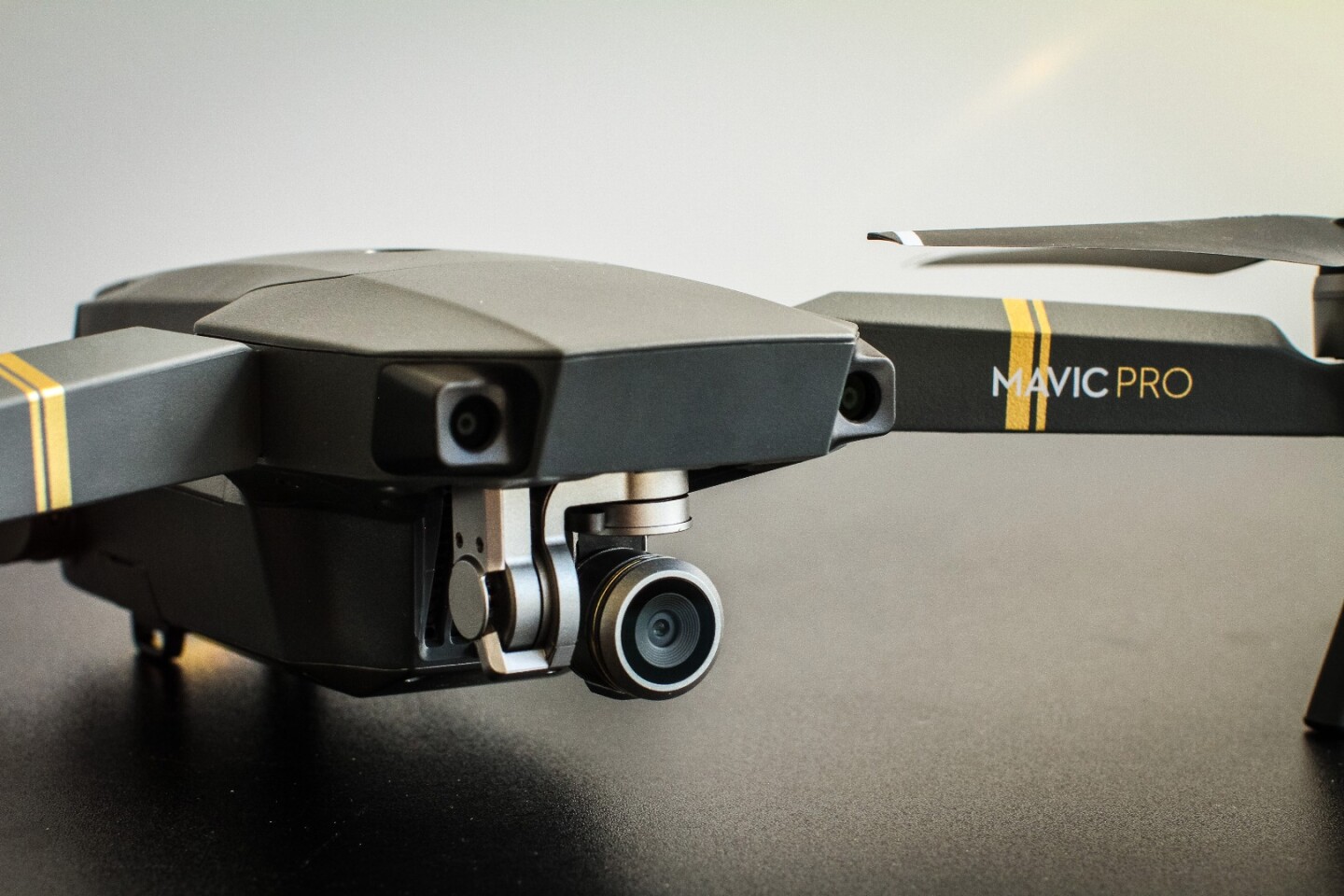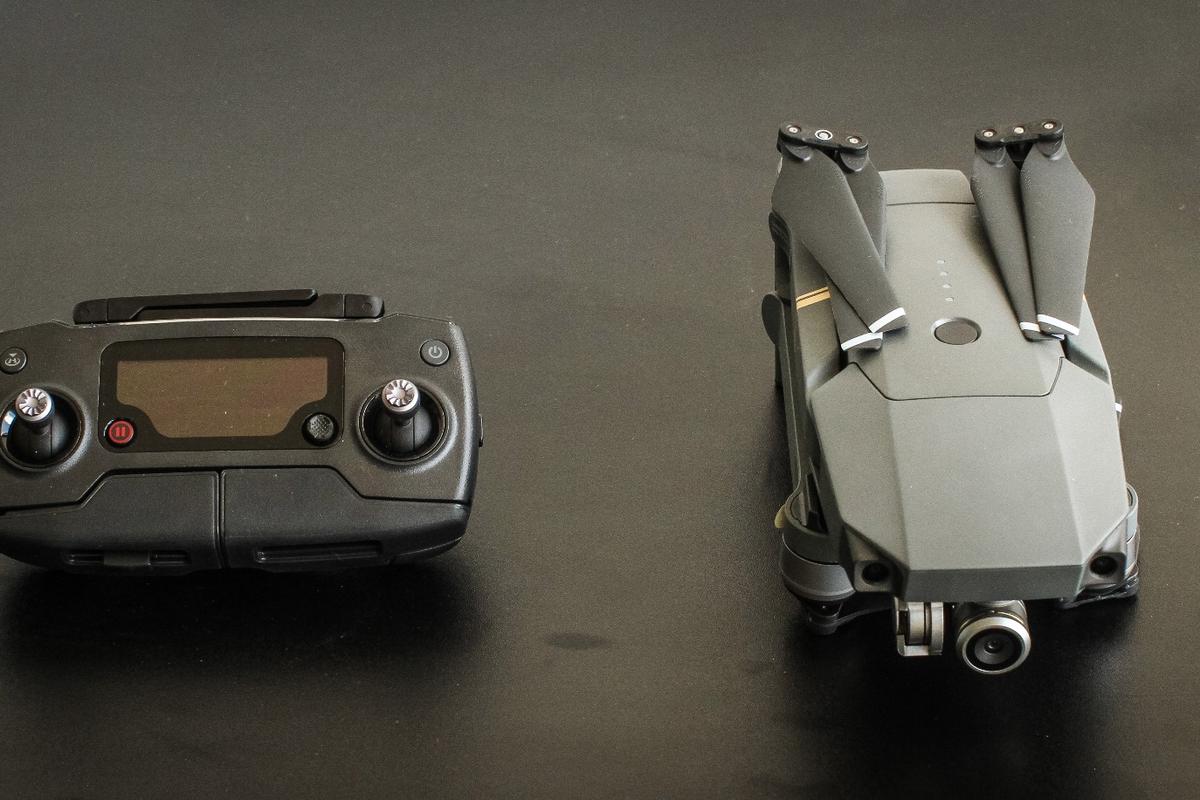The pace the drone industry moves at is terrifying. If you'd have told me last year I could have an aerial camera drone with all the functionality of the Phantom 4, but that could fold up and fit in my pocket, I wouldn't have believed you. And yet, here we are.
The DJI Mavic is freakin' tiny. It hits you the moment you see the box, which is about a third the size of a Phantom 4 box. Then it hits you again when you pull the drone out – I have genuinely had sandwich rolls bigger than this thing. It fits easily in the pocket of a pair of cargo pants, if you're the type of person who still rocks those.
The controller: tiny. The charger: tiny. Even the batteries look novelty size next to the Phantom gear I'm used to. The whole kit can be thrown in a backpack with plenty of room for everything else.

Mind you, once you open the propeller arms out and the self-straightening props open themselves out, the Mavic looks a lot closer to the size of a Phantom. And once you've opened the little bottom arms out and stuck your phone in the controller, that feels plenty solid in your hand too.
That's the essential magic trick here: the Mavic crams about 95 percent of what the Phantom 4 can do into a package that redefines portability in the segment. Seriously, it makes GoPro's Karma drone look huge and bulky.

Setup and teardown
The box the Mavic comes in is a very convenient and handy size for chucking in a bag, so you might well find you don't need to bother getting anything better to cart it about in.
Once you're at the spot, you unfold the arms of the drone – careful, the front and rear arms fold on different axes – and pull off the domed camera cover. There's also a small plastic gimbal lock that slides off before you can fly the drone.

The Mavic's 8-and-a-bit-inch (21 cm) props are themselves an ingenious folding arrangement. They attach to the motors with the same quick push-turn-lock system as the quick release props on the P4 and Inspire series drones, but they fold in half to keep the Mavic super compact. When you start the drone up, the blades fling themselves out to full width in an instant and you're off.

The remote control unfolds just as quickly. You simply pop the aerials up, pull the bottom arms out and apart, and wedge your phone in the middle of them, putting the screen under the thumb controls. I think I actually prefer this arrangement to the wobbly phone/tablet holder on the Phantom drones, but it should be noted, you can't use anything bigger than a phablet-sized phone as your screen.
Teardown is super quick: fold the props, fold the arms, gimbal lock, domed camera cover, phone out, arms in, aerials in, throw it in the box and go.
Basic Flight
Like everything DJI makes for the consumer market, the Mavic is simple, stable and a pleasure to fly. It's got all the Phantom 4's forward-facing obstacle avoidance tech built in, so it'll warn you when you're coming close to something and even prevent you from flying into it in standard mode – provided the obstacle is in front of the drone.
It's nowhere near the powerhouse the Phantom 4 is, though. In sport mode, the Mavic's about as quick, powerful and responsive as the Phantom 4 is in standard mode, with a top speed around 40 mph (65 km/h). In standard mode, frankly it feels a bit slow and careful for me, with a very limited tilt angle and ponderous vertical ascent speed. I should say, though, that once you've got the drone to the spot you want to film from, standard mode makes it easier to get a smooth shot.

The Phantom drones get pushed around a little bit on a windy day, but they're nearly twice the weight of the Mavic. And that certainly makes a difference. On a windy day, the Mavic finds itself working overtime to stay in one spot.
And that susceptibility to a strong breeze makes things all the more nervous considering the huge transmission range the Mavic enjoys – up to 7km in open terrain while still streaming back beautiful quality to the handset. If you've got to fight a breeze to get the drone home from a ways out, particularly over the water, it can be a slightly hairy experience.
One other surprise I found kind of neat was the way the Mavic lands. It won't let you fly below about a foot and a half over the ground, but if you hold the throttle stick down it will commence its own automatic landing, taking some of the bounce and drag out of your typical camera drone landing.
While it's descending, you can still move it horizontally for precise positioning. Once I got over the initial annoyance at the loss of control, I actually found myself liking it. But you do need to be careful where you put this thing down, because the props are much closer to the ground than on a Phantom, and can easily get wrapped up in long grass.

Advanced Modes
The Mavic packs in the full suite of DJI's advanced flight modes. That includes ActiveTrack, which lets you draw a box around your subject on the screen, then follows the subject around.
There's tap to fly, which lets you smoothly advance forward, steering the drone by tapping your phone screen. Points of Interest, which automatically circles your target, and waypoints, which allows you to move the drone precisely between points in space.
New modes I haven't seen before include Gesture mode, which lets you wave at the thing to tell it to take a selfie of you, and Tripod mode, which makes the drone extra slow and precise, particularly for indoor work. You can also fly the Mavic without getting the controller out, using your phone as the controller. Yikes, no thanks.
One mode DJI still doesn't offer, that I think is awesome, is something like the 3DR Solo drone's Cable Cam function, which lets you set several camera angles, and move smoothly between them at a rate managed by your throttle stick, the drone moving and rotating smoothly in between those pre-set angles. It's a brilliant way to set up and execute complex shots with moving subjects, and I'd love to see DJI build something like it.

Camera
The Mavic has a very similar camera to the Phantom 4 – an admirably sharp 4K/24 frames per second imaging system that can also shoot DNG RAW and JPG photos. There's also now live streaming to Facebook and YouTube, but to be honest this sort of thing seems gimmicky to me at this point.
In the name of miniaturization and portability, both the camera and the gimbal have shrunk to a comically tiny size. There are some tradeoffs in effect: the lens delivers a narrower field of view, the equivalent of a 28 mm lens on a 35 mm camera, where the Phantom 4's view is more like 20 mm. But it's still straight, decently sharp, it does a decent job of controlling chromatic aberration and shows very little distortion – and at the end of the day, there are plenty of reasons to prefer a slightly more zoomed-in look at your subjects anyway.

Dynamic range isn't spectacular, so you do have to think about the light. This is an area DJI can certainly improve on, particularly since we're starting to see mobile phone cameras with sensors that do some pretty impressive work in that department.

The gimbal can also get a bit overwhelmed when you're flying fast 'n' crazy in Sport mode, snapping to funny angles and getting its horizon all skewiff. There are tools in the new DJI GO app to let you fix this stuff on the fly, but it's a pair of problems we've never encountered on a Phantom.
The other key difference with the camera (and I'm not sure why this is the case) is that you have to manually choose your focus points by tapping on your phone screen. Focus is just not something I've ever had to think about on a drone before, so I find it a bit annoying.
Still, the 4K footage is sharp and beautifully detailed. There are multiple colour modes, including a flat cinema-style profile for post grading, and the overall camera output looks almost identical to what you'd get out of a Phantom 4. Stills, too, are terrific, especially when you shoot in DNG RAW and give them a little touch-up afterwards.

Conclusions
In the United States, the Mavic retails for US$999 – some US$200 cheaper than the Phantom 4. In Australia, for some reason, both cost the same AU$1699. Both drones are outstanding all-in-one midrange camera drone options, and each offers its own advantages.
For higher power, higher speed and a greater degree of stability in medium to high winds, the Phantom is your machine. But where portability is your primary concern, nothing we've ever seen comes close to the Mavic.
There are drones with better cameras, but they're a lot bigger. And there are smaller drones, but they're not pro-level video tools. The Mavic hits a sweet spot where you'd be happy to throw it in your hiking rucksack, or your Camelbak, or even your pocket, and still delivers clear, clean, stable images. Color us impressed.
Where to buy
Product page: DJI Innovations





















